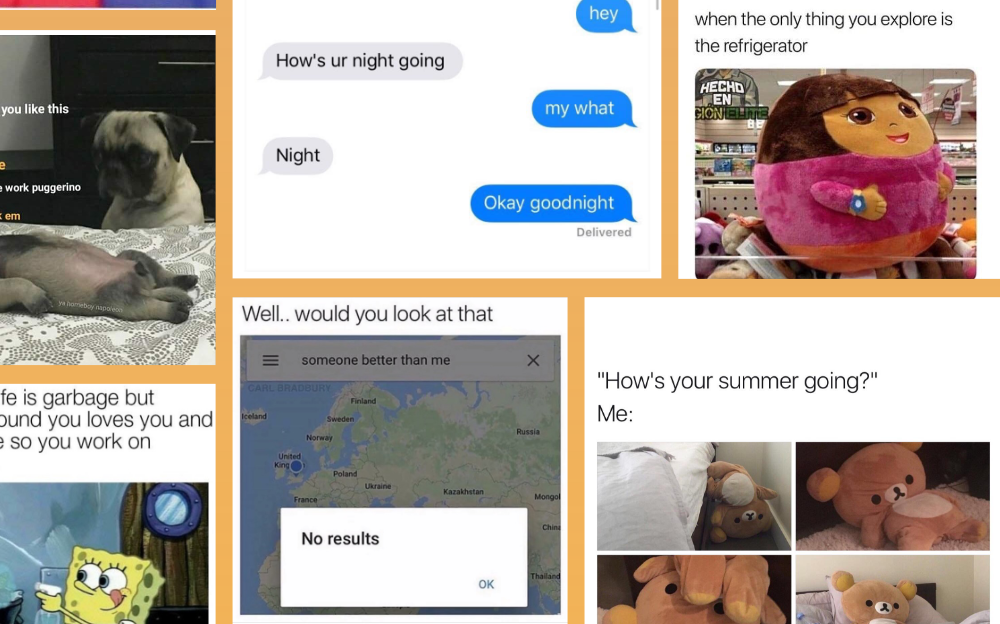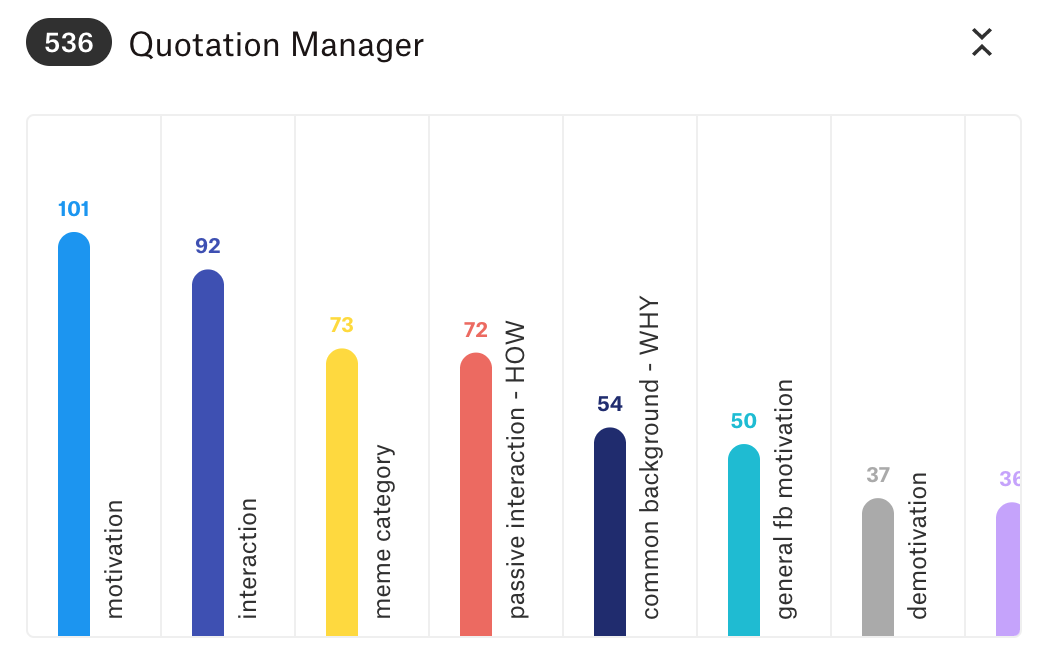Memes: Understanding Their Effects and How They Shape the Lives of Facebook Users
Advisor: Professor Hao-Chuan Wang
Topics: Social computing, Computer-mediated communication

I started this research study in my undergraduate studies at UC Davis. It's still a work in progress, so this page is meant to give a brief overview of my process, data collection, analysis, and findings. This is not a publication!
Background
For my research project, I studied Internet memes on Facebook. As a Facebook meme user myself, I noticed there was a resurgence in memes in the past 3-4 years. I became curious about what processes drove this Facebook users to engage with memes.
Understanding the usage of these memes on Facebook gives insight to pop culture, generational differences, how people are living, and current events in the world. It is important to document this behavior and figure out why and how memes engage users on Facebook, so we can understand human thoughts and motivations and capture societal trends.
The main research questions I have are: 1. How do people engage with memes on Facebook? 2. Why do people engage with memes on Facebook?
Research Preparation
I decided to move forward with a Qualitative interview study focused on Facebook meme users, but before I could do so I had to acquire IRB approval. This would allow me to conduct research with particpants.
After acquiring approval, I created a pre-screening questionnaire to make sure that people are eligible to become a participant of this study. People who are eligible must use Facebook and must be familiar with memes.
Designing the Interviews
To verify whether I was drafting viable pre-screening and interview questions, I had to conduct pilot screenings and studies. First, I conducted a pilot screening from a pool of eleven people to test general demographic questions but most importantly to verify whether Facebook was a viable platform to study meme usage. Once I received that confirmation, I needed to test my interview questions, so I conducted five pilot interviews with people within my network. Doing so helped me understand how to draft better interview questions through an iterative process and learn to take the role of an interviewer.
Data Collection
Recruitment. I posted flyers around the UC Davis campus from April 2019 to early May 2019. People who wanted to participate in the study had to complete a pre- screening questionnaire, which would evaluate their eligibility for the interview portion. All participants were required to use Facebook and have exposure with memes on the platform. From a pool of 120 eligible candidates, I recruited a total of 20 participants (7 Male, 13 Female), aged from 18 to 25.
Study Procedure. Once participants were selected, I proceeded to interview all 20 participants within a 3 week time-frame. They were all compensated with $5 Amazon gift cards for their time. Each interview was approximately 30 minutes long, and had two distinct parts. The first part of the interview was a structured like conventional interview. I asked questions regarding their current Facebook usage, and their meme usage on Facebook. I also asked about Facebook groups and how they influenced their meme usage and about other social networking sites such has Twitter, Instagram, and Reddit with regards to memes depending on which sites participants used. The second part of the interview required participants to log in to their personal Facebook and recall and find memes they had recently encountered. I asked their interpretation of the memes, why they enjoyed it, and how they came across it on Facebook. I audio recorded each interview.
To clarify the steps of our app and the different user interactions, we drafted the following user flow diagram. This helped map out possible actions and the user's experience journey throughout Beanstalk.
Coding Process
After collecting data, I began a coding process to look for central themes. I used the program ATLAS.ti, which made the coding process more efficient because I was able to use their features to categorize theme by color. Since it was my first time coding data, I wasn’t sure how I should categorize my data . I also learned that as I read more and more of my data, I develop new codes and I must read through my interviews once more with my new codes in mind. These were some of the many codes I formed during the process.

How do FB users interact with memes?

The participants stated their interactions along the lines of These categories of meme engagement can be carried out in two ways: an uncontrolled process and a controlled process. The uncontrolled process is when FB users encounter memes unwillingly. This could be scrolling through a newsfeed and seeing memes on there. A controlled process is when FB users intentionally choose to interact with a meme such as seeking out memes such as actively searching for a meme page, reacting to them, or sharing them with others.
Understanding the motivations behind meme engagement

Three main drivers of meme engagement were knowledge, desire for knowledge growth, and Facebook’s Environment. Knowledge is a broad term that I have categorized into three areas.
1. Meme Cues: This knowledge can be described as what the Facebook user knows about the content on the meme. For example:
2. Shared Knowledge: The Facebook user understands another Facebook friend’s interests, etc. This drives the initial user to think about the person of interest.
3. Knowledge of Self: The Facebook user identifies part of himself or herself within the meme, causing it to be “relatable”.
Desire for knowledge growth is the spark of curiosity that arrives when a FB user does not understand the content within a meme. This will drive him or her to seek out more information about it.
Environment encompasses Facebook’s features and characteristics that users encounter. Some examples are Groups, Pages, Messenger, Newsfeed, and privacy settings. For example, some participants stated that privacy was a concern for them on FB; they would be less likely to like or share a meme if they knew other FB friends could see their actions.
Conclusions and Reflections
Ultimately through this research study, I have narrowed down how users engage with memes and why they do so. The interaction is based on a controlled and uncontrolled process with regards to intentionally interacting with a meme and just happening to encounter them, respectively. The underlying motivations with meme engagement come from a combination of FB's environment and how well users understand their friends and themselves.
Overall, this was a fascinating study because I was able to uncover people's behaviors and motivations with regards to using memes on Facebook. Since this was my first major research project, I learned a lot about Qualitative research and developed knowledge in how to code data. I also realized that conducting research is not an easy task. After all, I had to answer questions that no one has answered before through a systematic process. Above all, this has given me a taste of social computing research, and I hope to continue to generate new knowledge in this area.